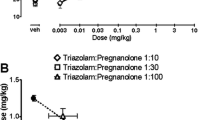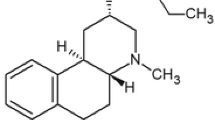Abstract
Non-deprived male rats were familiarised with a highly palatable diet until baseline consumption in a 30-min daily access period had stabilised. Stereospecificity of the hyperphagic effect of benzodiazepine receptor agonists was demonstrated using two enantiomers, the (S)-enantiomer being Ro11-3128 (methylclonazepam) and the (R)-enantiomer, Ro11-3624. The benzodiazepine receptor antagonists, Ro15-1788 and CGS 8216, reversed the hyperphagic effect of Ro11-3128. These data confirm the mediation of the hyperphagic effect of benzodiazepines by specific receptors. In further experiments, the effects of the pyrazoloquinolines CGS 9895 and CGS 9896 were examined both alone and also in combination with clonazepam. In doses of 1.25-10.0 mg/kg, neither CGS 9895 nor CGS 9896, when given alone, had a significant effect on the consumption of the palatable diet. Both, however, dose-dependently antagonised the hyperphagic effect of clonazepam. In a test of palatable food consumption, therefore, both compounds can be characterised as benzodiazepine antagonists.
Similar content being viewed by others
References
Ator NA, Griffiths RR (1985) Lorazepam and pentobarbital discrimination: interactions with CGS 8216 and caffeine. Eur J Pharmacol 107: 169–181
Bennett DA (1985) The non-sedating anxiolytic CGS 9896 produces discriminative stimuli that may be related to an anxioselective effect. Life Sci 37: 703–709
Bennett DA, Petrack B (1984) CGS 9896: a nonbenzodiazepine, nonsedating potential anxiolytic. Drug Dev Res 4: 75–82
Bernard PS, Bennett DA, Pastor G, Yokoyama N, Liebman JM (1985) CGS 9896: agonist-antagonist benzodiazepine receptor activity revealed by anxiolytic, anticonvulsant and muscle relaxation assessment in rodents. J Pharmacol Exp Ther 235: 98–105
Brown C, Martin I, Jones B, Oakley N (1984) In vivo determination of efficacy of pyrazoloquinolines at the benzodiazepine receptor. Eur J Pharmacol 103: 139–143
Cooper SJ (1980) Benzodiazepines as appetite-enhancing compounds. Appetite 1: 7–19
Cooper SJ (1986) Hyperphagic and anorectic effects of β-carbolines in a palatable food consumption test: comparisons with triazolam and quazepam. Eur J Pharmacol 120: 257–265
Cooper SJ, Barber DJ, Gilbert DB, Moores WR (1985) Benzodiazepine receptor ligands and the consumption of a highly palatable diet in non-deprived male rats. Psychopharmacology 86: 348–355
Cooper SJ, Gilbert DB (1985) Clonazepam-induced hyperphagia in nondeprived rats: tests of pharmacological specificity with Ro5-4864, Ro5-3663, Ro15-1788 and CGS 9896. Pharmacol Biochem Behav 22: 753–760
Cooper SJ, Moores WR (1985a) Chlordiazepoxide-induced hyperphagia in non-food-deprived rats: effects of Ro15-1788, CGS 8216 and ZK 93426. Eur J Pharmacol 112: 39–45
Cooper SJ, Moores WR (1985b) Benzodiazepine-induced hyperphagia in the non deprived rat: comparisons with CL 218, 872, zopiclone, tracazolate and phenobarbital. Pharmacol Biochem Behav 23: 169–172
Foltin RW, Ellis S, Schuster CR (1985) Specific antagonism by Ro15-1788 of benzodiazepine-induced increases in food intake in rhesus monkeys. Pharmacol Biochem Behav 23: 249–252
Gee KW, Yamamura HI (1982) A novel pyrazoloquinoline that interacts with brain benzodiazepine receptors: characterization of some in vitro and in vivo properties of CGS 9896. Life Sci 30: 2245–2252
Haefely W, Kyburz E, Gerecke M, Mohler H (1985) Recent advances in the molecular pharmacology of benzodiazepine receptors and in the structure-activity relationships of their agonists and antagonists. In: Testa B (ed) Advances in drug research, volume 14. Academic Press, London, pp 165–322
Klockgether T, Schwarz M, Turski L, Sontag K-H (1985) ZK 91296, an anticonvulsant β-carboline which lacks muscle relaxant properties. Eur J Pharmacol 110: 309–315
Lister RG, Greenblatt DJ, File SE (1984) A pharmacokinetic study of CGS 8216, a benzodiazepine receptor ligand, in the rat. Psychopharmacology 84: 420–422
Mansbach RS, Stanley JA, Barrett JE (1984) Ro15-1788 and β-CCE selectively eliminate diazepam-induced feeding in the rabbit. Pharmacol Biochem Behav 20: 763–766
Nakamura T, Carney JM (1984) Antagonism by CGS 8216 and Ro15-1788, benzodiazepine antagonists, of the action of chlordiazepoxide on timing behavior in rats. Pharmacol Biochem Behav 21: 381–385
Patel JB, Martin C, Malick JB (1983) Differential antagonism of the anticonflict effects of typical and atypical anxiolytics. Eur J Pharmacol 86: 295–298
Pellow S, File SE, Herberg LJ (1984) Intracranial self-stimulation distinguishes between two benzodiazepine antagonists. Neurosci Lett 47: 173–177
Petersen EN, Jensen LH, Honoré T, Braestrup C, Kehr W, Stephens DN, Wachtel H, Seidelman D, Schmiechen R (1984) ZK 91296, a partial agonist at benzodiazepine receptors. Psychopharmacology 83: 240–248
Petrack B, Czernik AJ, Cassidy JP, Bernard P, Yokoyama N (1983) Benzodiazepine receptor ligands with opposing pharmacologic actions. In: Biggio G, Costa E (eds) Benzodiazepine recognition site ligands: biochemistry and pharmacology, Raven Press, New York, pp 129–137
Sanger DJ (1984) Chlordiazepoxide-induced hyperphagia in rats: lack of effect of GABA agonists and antagonists. Psychopharmacology 84: 388–392
Sanger DJ, Joly D (1985) Anxiolytic drugs and the acquisition of conditioned fear in mice. Psychopharmacology 85: 284–288
Sanger DJ, Joly D, Zivkovic B (1985) Behavioral effects of nonbenzodiazepine anxiolytic drugs: a comparison of CGS 9896 and zopiclone with chlordiazepoxide. J Pharmacol Exp Ther 232: 831–837
Sepinwall J (1985) Behavioral effects of antianxiety agents: possible mechanisms. In: Seiden LS, Balster RL (eds) Behavioral pharmacology. The current status. Liss New York, pp 181–203
Shannon HE, Herling S (1983a) Discriminative stimulus effects of diazepam in rats: evidence for a maximal effect. J Pharmacol Exp Ther 227: 160–166
Shannon HE, Herling S (1983b) Antagonism of the discriminative effects of diazepam by pyrazoloquinolines in rats. Eur J Pharmacol 92: 155–157
Shannon HE, Thompson WA (1985) Pyrazoloquinoline benzodiazepine receptor ligands: effects on schedule-controlled behavior in dogs. Pharmacol Biochem Behav 23: 317–323
Spencer DG, Lal H (1983) CGS 9896, a chloro-derivative of the diazepam antagonist CGS 8216, exhibits anxiolytic activity in the pentylenetetrazol — saline discrimination test. Drug Dev Res 3: 365–370
Stephens DN, Kehr W (1985) β-carbolines can enhance or antagonize the effects of punishment in mice. Psychopharmacology 85: 143–147
Winer BJ (1971) Statistical principles in experimental design. McGraw-Hill, New York
Wood PL, Loo P, Braunwalder A, Yokoyama N, Cheney DL (1984) In vitro characterization of benzodiazepine receptor agonists, antagonists, inverse agonists and agonist/antagonists. J Pharmacol Exp Ther 231: 572–576
Yokoyama N, Ritter B, Neubert AD (1982) 2-Arylpyrazolo [4,3-c] quinolin-3-ones: novel agonist, partial agonist, and antagonists of benzodiazepines. J Med Chem 25: 337–339
Author information
Authors and Affiliations
Rights and permissions
About this article
Cite this article
Cooper, S.J., Yerbury, R.E. Benzodiazepine-induced hyperphagia: Stereospecificity and antagonism by pyrazoloquinolines, CGS 9895 and CGS 9896. Psychopharmacology 89, 462–466 (1986). https://doi.org/10.1007/BF02412122
Received:
Revised:
Issue Date:
DOI: https://doi.org/10.1007/BF02412122




